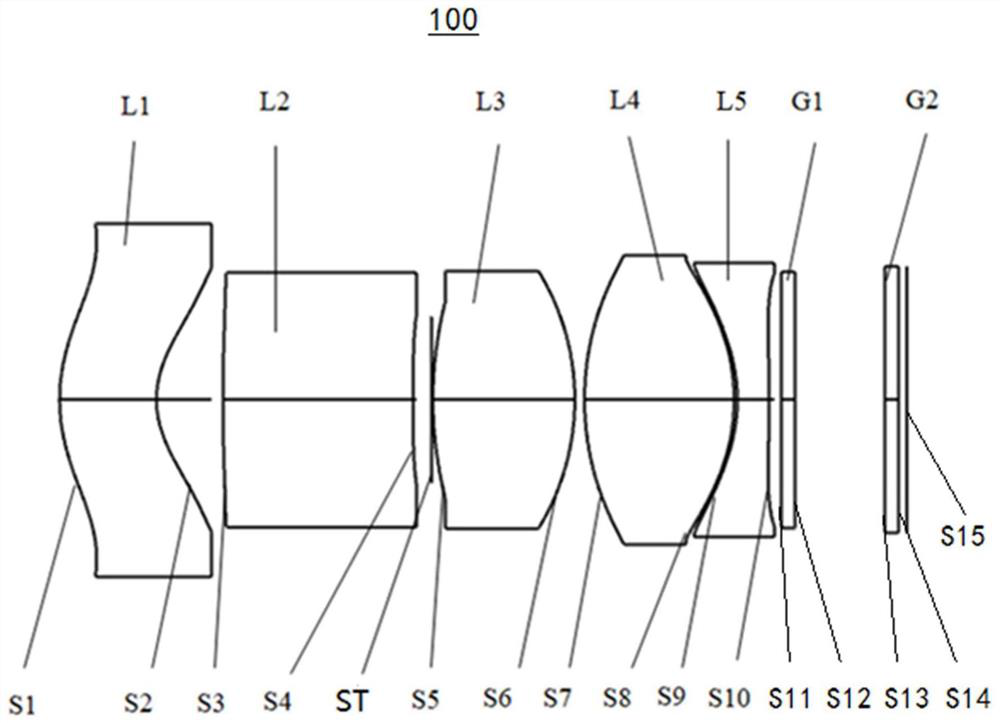Optical imaging lens and imaging equipment
An optical imaging lens and lens technology, which is applied in the field of optical lens, can solve the problems of poor target recognition, inability to correctly identify and alarm, etc., and achieve good effect, satisfy the use characteristics, and large focal length
- Summary
- Abstract
- Description
- Claims
- Application Information
AI Technical Summary
Problems solved by technology
Method used
Image
Examples
Embodiment 1
[0073] see figure 2 , which is a schematic structural diagram of the optical imaging lens 100 provided by the first embodiment of the present application. The optical imaging lens 100 sequentially includes, from the object side to the imaging surface: a first lens L1, a second lens L2, a diaphragm ST, a third lens L3, a fourth lens L4, a fifth lens L5, a filter G1 and a protective glass G2 .
[0074] The first lens L1 has negative refractive power, the object side S1 is convex, and the image side S2 is concave.
[0075] The second lens L2 has positive refractive power, the object side S3 is convex at the near optical axis, and the image side S4 is concave at the near optical axis.
[0076] The third lens L3 has positive refractive power, and both the object side S5 and the image side S6 are convex.
[0077] The fourth lens L4 has positive refractive power, and both the object side S7 and the image side S8 are convex.
[0078] The fifth lens L5 has negative refractive powe...
Embodiment 2
[0093] see Image 6 , which is a schematic structural diagram of the optical imaging lens 200 provided by the second embodiment of the present application. The optical imaging lens 200 provided by the second embodiment of the present application is substantially the same as the optical imaging lens 100 provided by the first embodiment, and the main difference is that the first lens L1 of the optical imaging lens 200 provided by the second embodiment of the present application adopts Plastic aspheric lens, the second lens L2 has negative refractive power, the object side S3 is concave, the image side S4 is convex, and the curvature radius, thickness and material selection of each lens are different.
[0094]Please refer to Table 2-1. The relevant parameters of each lens in the optical imaging lens 200 provided by the second embodiment of the present application are shown in Table 2-1.
[0095] table 2-1
[0096]
[0097] Referring to Table 2-2, the aspheric parameters of t...
Embodiment 3
[0106] see Figure 10 , which is a schematic structural diagram of the optical imaging lens 300 provided by the third embodiment of the present application. The optical imaging lens 300 provided by the third embodiment of the present application is substantially the same as the optical imaging lens 100 provided by the first embodiment, and the main difference is that the second lens L2 of the optical imaging lens 300 provided by the embodiment of the present application has negative light The power, as well as the curvature radius, thickness and material selection of each lens are different.
[0107] Please refer to Table 3-1. The relevant parameters of each lens in the optical imaging lens 300 provided by the third embodiment of the present application are shown in Table 3-1.
[0108] Table 3-1
[0109]
[0110]
[0111] Referring to Table 3-2, the aspheric parameters of the first lens L1, the second lens L2, the fourth lens L4 and the fifth lens L5 in the embodiments...
PUM
 Login to View More
Login to View More Abstract
Description
Claims
Application Information
 Login to View More
Login to View More - R&D
- Intellectual Property
- Life Sciences
- Materials
- Tech Scout
- Unparalleled Data Quality
- Higher Quality Content
- 60% Fewer Hallucinations
Browse by: Latest US Patents, China's latest patents, Technical Efficacy Thesaurus, Application Domain, Technology Topic, Popular Technical Reports.
© 2025 PatSnap. All rights reserved.Legal|Privacy policy|Modern Slavery Act Transparency Statement|Sitemap|About US| Contact US: help@patsnap.com



